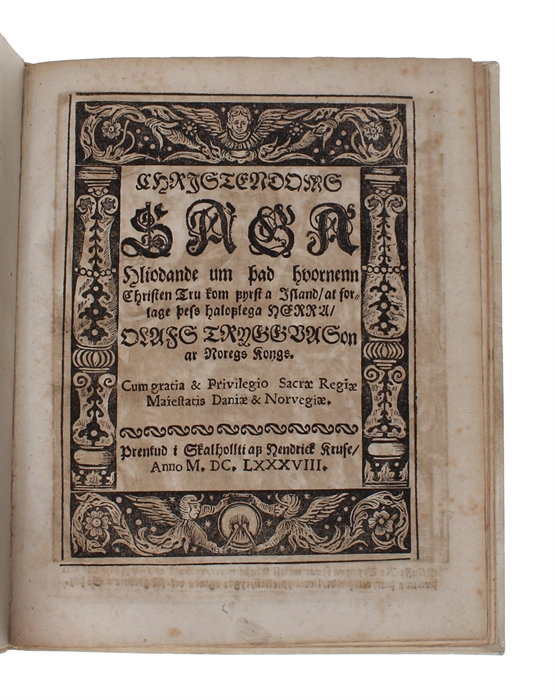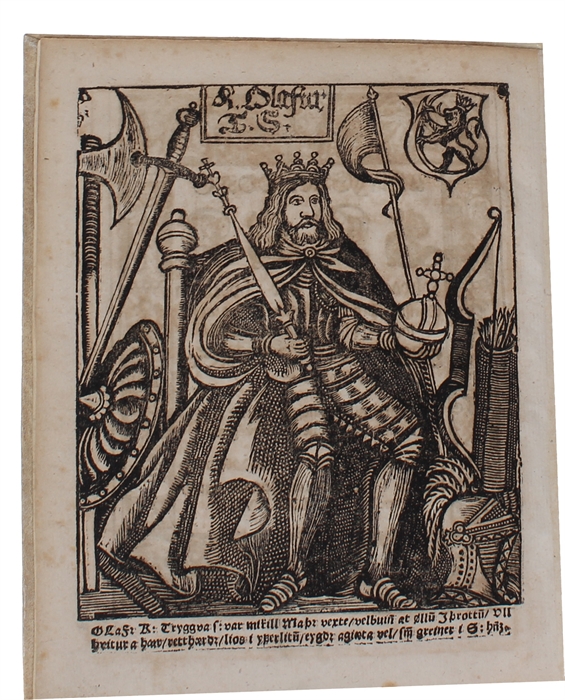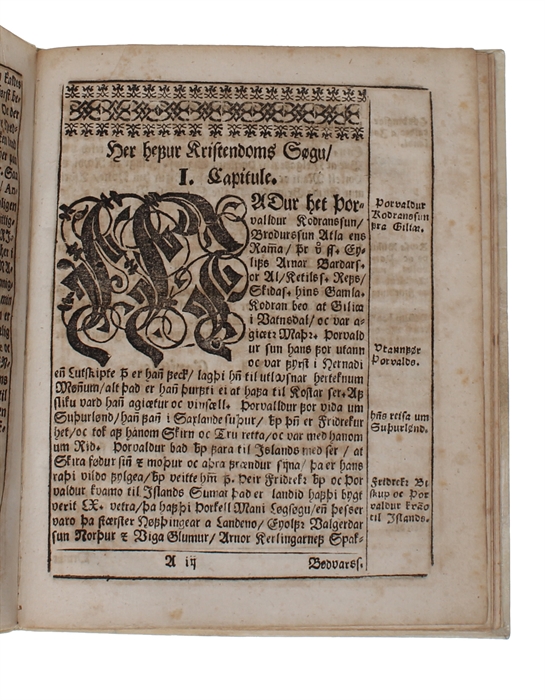ONE OF THE FIRST SAGAS PRINTED ON ICELAND
THORLAKSSON, THORDUR (edt.).
Christendoms Saga. Hliodane um thad hvornenn Christen Tru kom fyrst a Island/ at forlage thes haloflega Herru/ Olufs Tryggvason ar Noregs Kongs. Cum gratia & Privilegio Sacrae Regiae Maiestatis Daniae & Norvegiae.
Skalhollt, Hendrik Kruse, 1688.
4to. Bound in a nice newer, simple full limp vellum binding. Very light brownspotting. An excellent, clean, and fresh copy. Title-page with wide woodcut ornamental border, verso with full-page woodcut portrait of Olav Tryggvason. (4), 25, (2) pp.
The rare editio princeps of 'Christendoms Saga' or 'Kristni saga', constituting one of the very first sagas printed on Iceland. The printing of 'Christendoms Saga' in 1688 was a significant event in the history of Icelandic literature and culture. The saga is a historical narrative of the introduction of Christianity to Iceland in the 10th century and had been orally transmitted for centuries. The printing of the saga in 1688 allowed for wider dissemination of the story and cemented the saga's place in Icelandic literary tradition. Iceland's first - and, until 1773, only active - printing press was established around 1530 in Holar, the island's northern episcopal, where it operated until the late seventeenth century. The press came into the private possession of Bishop Gudbrandur Thorlaksson (ca. 1542-1627) and his descendants, several of whom became bishops as well. In 1648, Brynjolfur Sveinsson (1605-1675), bishop of Iceland's southern diocese Skalholt asked the Danish authorities for permission to establish another printing press to print historical texts and sagas alongside religious books. The "Christendoms Saga" is a significant piece of literature that provides valuable insights into the social, cultural, and religious transformation of Iceland during that period. The saga begins with the arrival of two Christian missionaries, Thorvald Konradsson and Thangbrandur, who are sent to Iceland by the Norwegian king Olaf Tryggvason. The missionaries face stiff resistance from the pagan chieftains who see Christianity as a threat to their traditional way of life "Whereas many accounts of Iceland's conversion to Christianity occur within the context of longer works, lives of Olaf Tryggvason or Sagas of Icelanders, Kristni saga (i.e. "Christendoms Saga") sets out to tell the history of Icelandic Christianity independently, as its opening sentence explicitly states: Nú hefr þat, hversu kristni kom á Ísland 'Now this is the beginning of how Christianity came to Iceland". (Duke, kristni saga and its sources: some revaluations) The present work is based on Jón Erlendsson's copy (AM 105) of Hauksbók (AM 371), a manuscript from the first decade of the 14th century, which is the only version of it preserved, whose main theme is kristnitaka, that is, the beginnings of Christianity in Iceland and the activity of Ísleifur Gissurarson and Gissur Ísleifsson, who were bishops of Skálholt, between 1056-1080 and 1082-1111. Klose 5485
The printing in Holar was solely centered on religious texts and are of the utmost scarcity and are never found in the trade.
Not wanting the competition, his northern colleague in Holar intervened to halt this initiative, and nothing came of the plan for a second press nor of the printing of historical subject-matter for the time being. After Thordur Torlaksson (1637-1697), great-grandson of Bishop Gudbrandur Thorlaksson, became bishop in 1674, a monopoly from the King was granted, on April 7th, 1688, to print historical books on Iceland. Shortly after, namely the same year that the grant was given, the present work as well as "Landnamabok" and "Islendingabok" was printed - all three works being of the utmost scarcity. The printing press remained the sole press in Iceland until 1773.
"Kristni saga is the only work in which the missions to Iceland form the main subject of the narrative and the organisational principle of the whole; it shares with Bede’s Ecclesiastical History the distinction of being one of the few works in the Middle Ages which can justly be described as ‘missionary’ history"." (Grønlie, Introduction to "Kristni saga, the book of the icelanders").
Pre-Eighteenth-Century Icelandic prints are in general very rare and are almost never found in the trade. The Skalhollt-prints are of special interest since they were the first in Iceland to print secular and historical works including the sagas thereby making a seminal contribution to preserving the Icelandic cultural heritage.
Fiske p. 331, IcF64AA112
Order-nr.: 60380




